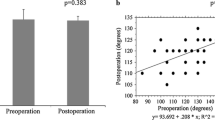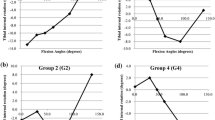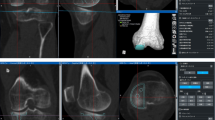Abstract
Purpose
To investigate whether intraoperative kinematics obtained by navigation systems can be divided into several kinematic patterns and to assess the correlation between the intraoperative kinematics with maximum flexion angles before and after total knee arthroplasty (TKA).
Method
Fifty-four posterior-stabilised (PS) TKA implanted using an image-free navigation system were evaluated. At registration and after implantation, tibial internal rotation angles at maximum extension, 30°, 45°, 60°, 90°, and maximum flexion were collected. The rotational patterns were divided into four groups and were examined the correlation with maximum flexion before and after operation.
Results
Tibial internal rotation from 90° of flexion to maximum flexion at registration was correlated with maximum flexion angles pre- and postoperatively. The four groups showed statistically different kinematic patterns. The group with tibial external rotation up to 90° of flexion, following tibial internal rotation at registration, achieved better flexion angles, compared to those of another groups (126.7° ± 12.0°, p < 0.05). The group with tibial external rotation showed the worst flexion angles (80.0° ± 40.4°, p < 0.05). Furthermore, the group with limited extension showed worse flexion angles (111.6° ± 8.9°, p < 0.05).
Conclusion
Navigation-based kinematic patterns found at registration predict postoperative maximum flexion angle in PS TKA. Navigation-based kinematics can be useful information during TKA surgery.
Level of evidence
Diagnostic studies, development of diagnostic criteria in a consecutive series of patients and a universally applied “gold” standard, Level II.




Similar content being viewed by others
References
Akagi M, Mori S, Nishimura S, Nishimura A, Asano T, Hamanishi C (2005) Variability of extraarticular tibial rotation references for total knee arthroplasty. Clin Orthop Relat Res 436:172–176
Casino D, Zaffagnini S, Martelli S, Lopomo N, Bignozzi S, Iacono F, Russo A, Marcacci M (2009) Intraoperative evaluation of total knee replacement: kinematic assessment with a navigation system. Knee Surg Sports Traumatol Arthrosc 17(4):369–373
Cavaignac E, Carpentier K, Pailhe R, Luyckx T, Bellemans J (2014) The role of the deep medial collateral ligament in controlling rotational stability of the knee. Knee Surg Sports Traumatol Arthrosc. doi:10.1007/s00167-014-3095-1
Chinzei N, Ishida K, Matsumoto T, Kuroda Y, Kitagawa A, Kuroda R, Akisue T, Nishida K, Kurosaka M, Tsumura N (2014) Evaluation of patellofemoral joint in ADVANCE Medial-pivot total knee arthroplasty. Int Orthop 38(3):509–515
Cromie MJ, Siston RA, Giori NJ, Delp SL (2008) Posterior cruciate ligament removal contributes to abnormal knee motion during posterior stabilized total knee arthroplasty. J Orthop Res 26(11):1494–1499
Dennis DA, Komistek RD, Hoff WA, Gabriel SM (1996) In vivo knee kinematics derived using an inverse perspective technique. Clin Orthop Relat Res 331:107–117
Dennis DA, Komistek RD, Mahfouz MR, Walker SA, Tucker A (2004) A multicenter analysis of axial femorotibial rotation after total knee arthroplasty. Clin Orthop Relat Res 428:180–189
Fujimoto E, Sasashige Y, Masuda Y, Hisatome T, Eguchi A, Masuda T, Sawa M, Nagata Y (2013) Significant effect of the posterior tibial slope and medial/lateral ligament balance on knee flexion in total knee arthroplasty. Knee Surg Sports Traumatol Arthrosc 21(12):2704–2712
Ishida K, Matsumoto T, Tsumura N, Kubo S, Kitagawa A, Chin T, Iguchi T, Kurosaka M, Kuroda R (2011) Mid-term outcomes of computer-assisted total knee arthroplasty. Knee Surg Sports Traumatol Arthrosc 19(7):1107–1112
Jenny JY, Clemens U, Kohler S, Kiefer H, Konermann W, Miehlke RK (2005) Consistency of implantation of a total knee arthroplasty with a non-image-based navigation system: a case-control study of 235 cases compared with 235 conventionally implanted prostheses. J Arthroplasty 20(7):832–839
Kanekasu K, Banks SA, Honjo S, Nakata O, Kato H (2004) Fluoroscopic analysis of knee arthroplasty kinematics during deep flexion kneeling. J Arthroplasty 19(8):998–1003
Kim SH, Lee HJ, Jung HJ, Lee JS, Kim KS (2013) Less femoral lift-off and better femoral alignment in TKA using computer-assisted surgery. Knee Surg Sports Traumatol Arthrosc 21(10):2255–2262
Klein GR, Parvizi J, Rapuri VR, Austin MS, Hozack WJ (2004) The effect of tibial polyethylene insert design on range of motion: evaluation of in vivo knee kinematics by a computerized navigation system during total knee arthroplasty. J Arthroplasty 19(8):986–991
Koh IJ, Chang CB, Kang YG, Seong SC, Kim TK (2013) Incidence, predictors, and effects of residual flexion contracture on clinical outcomes of total knee arthroplasty. J Arthroplasty 28(4):585–590
Komistek RD, Dennis DA, Mahfouz M (2003) In vivo fluoroscopic analysis of the normal human knee. Clin Orthop Relat Res 410:69–81
Martin A, Wohlgenannt O, Prenn M, Oelsch C, von Strempel A (2007) Imageless navigation for TKA increases implantation accuracy. Clin Orthop Relat Res 460:178–184
Massin P, Petit A, Odri G, Ducellier F, Sabatier C, Lautridou C, Cappelli M, Hulet C, Canciani JP, Letenneur J, Burdin P, Societe d’orthopedie de lo (2009) Total knee arthroplasty in patients with greater than 20 degrees flexion contracture. Orthop Traumatol Surg Res 95(4 Suppl 1):S7–S12
Matsuda S, Kawahara S, Okazaki K, Tashiro Y, Iwamoto Y (2013) Postoperative alignment and ROM affect patient satisfaction after TKA. Clin Orthop Relat Res 471(1):127–133
Matsuzaki T, Matsumoto T, Kubo S, Muratsu H, Matsushita T, Kawakami Y, Ishida K, Oka S, Kuroda R, Kurosaka M (2013) Tibial internal rotation is affected by lateral laxity in cruciate-retaining total knee arthroplasty: an intraoperative kinematic study using a navigation system and offset-type tensor. Knee Surg Sports Traumatol Arthrosc 22(3):615–620
Matsuzaki T, Matsumoto T, Muratsu H, Kubo S, Matsushita T, Kawakami Y, Ishida K, Oka S, Kuroda R, Kurosaka M (2013) Kinematic factors affecting postoperative knee flexion after cruciate-retaining total knee arthroplasty. Int Orthop 37(5):803–808
Ngai V, Wimmer MA (2009) Kinematic evaluation of cruciate-retaining total knee replacement patients during level walking: a comparison with the displacement-controlled ISO standard. J Biomech 42(14):2363–2368
Seon JK, Park JK, Shin YJ, Seo HY, Lee KB, Song EK (2011) Comparisons of kinematics and range of motion in high-flexion total knee arthroplasty: cruciate retaining versus substituting designs. Knee Surg Sports Traumatol Arthrosc 19(12):2016–2022
Siston RA, Giori NJ, Goodman SB, Delp SL (2006) Intraoperative passive kinematics of osteoarthritic knees before and after total knee arthroplasty. J Orthop Res 24(8):1607–1614
Tei K, Ishida K, Matsumoto T, Kubo S, Sasaki H, Shibanuma N, Akisue T, Nishida K, Kurosaka M, Kuroda R (2012) Novel image-matching software for postoperative evaluation after TKA. Orthopedics 35(12):e1711–e1715
Victor J, Banks S, Bellemans J (2005) Kinematics of posterior cruciate ligament-retaining and -substituting total knee arthroplasty: a prospective randomised outcome study. J Bone Joint Surg Br 87(5):646–655
Author information
Authors and Affiliations
Corresponding author
Rights and permissions
About this article
Cite this article
Ishida, K., Shibanuma, N., Matsumoto, T. et al. Navigation-based femorotibial rotation pattern correlated with flexion angle after total knee arthroplasty. Knee Surg Sports Traumatol Arthrosc 24, 89–95 (2016). https://doi.org/10.1007/s00167-014-3340-7
Received:
Accepted:
Published:
Issue Date:
DOI: https://doi.org/10.1007/s00167-014-3340-7




